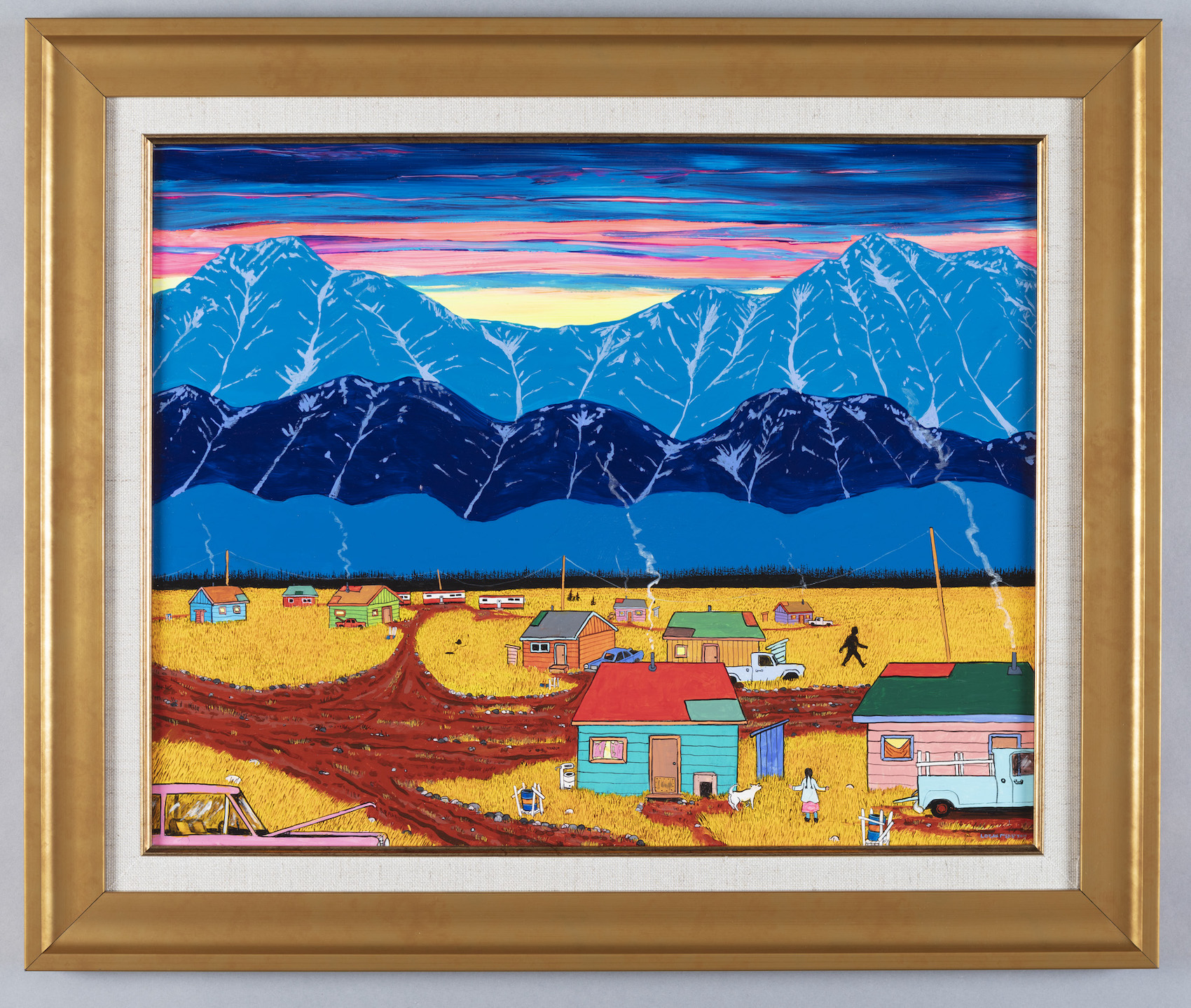Art in Focus: "Abby Saw a Sasquatch" by Jim Logan

"Abby Saw a Sasquatch," 2019; Painting; acrylic on Masonite; Jim Logan: Born New Westminster, British Columbia, 1955; University of Alberta Museums, University of Alberta Museums Art Collection; 2021.2.1
The painting Abby Saw a Sasquatch, by Cree/Sioux-Métis artist Jim Logan is a recent acquisition to the University of Alberta Museums Art Collection. This painting presents a mountainous village scene where a young girl looks towards a large silhouetted figure walking amongst the houses. Abby and the Sasquatch are the only figures in this brightly painted landscape that is otherwise filled with kit houses and abandoned cars. More importantly, the painting captures a brief moment of surprise and wonder for both Abby and the Sasquatch.
The legend of the Sasq’ets (sess-k-uts), or the Sasquatch as it is known by its Anglicized name, has a deep history among the Indigenous people of the Lower Mainland region of British Columbia where Logan was born. For the Sts’ailes (also known as Chehalis), a Coast Salish First Nation, the Sasq’ets is part of their cosmology.1 The Sasq’ets are ‘hairy men’ who inhabit both the physical and spiritual realms. To see a Sasq’ets “is viewed as a gift and as a bestowal of responsibility within the Sts’ailes community.”2 Today the Sts’ailes community annually celebrates “Sasquatch Days” with two-days of storytelling, canoe races, and games in the Harrison River Valley.3
Part of the ‘Village’ works of art series, Logan views this painting as part documentary where he has portrayed various realities of Indigenous life in Canada. On the overall series he writes, “I intentionally left subtle hints depicting the harsh living conditions in certain Indigenous communities I’ve lived in or otherwise became familiar with between 1960 and 1990.”4 In Abby Saw a Sasquatch, Logan brings together the story of the Sasq’ets, his observations, and the vividness of a painterly visual narration.
Trained at the Kootenay School of Art in Nelson, British Columbia, Jim Logan has had a multifaceted career as an artist, curator, arts administrator, lay minister, and writer. A long-time arts administrator with the Canada Council for the Arts, Logan was also the co-founder and president of the Society of Yukon Artists of Native Ancestry (SYANA) from 1988-89. He continues to live and work in Ottawa, Ontario.5
Much of Logan’s current work focuses on the daily life of Indigenous peoples with the intention that audiences formulate their own insights on his work, noting that, “as an artist, my intentions are never to focus solely on political matters. I simply want to record the pathos of living under the hegemonic condition we find ourselves in today.”6
The University of Alberta Museums Art Collection’s renewed focus on contemporary Indigenous art seeks to address gaps in our collection mandate and to remind viewers of the changing yet continued histories that inform our world, particularly in western Canada. The University of Alberta Museums Art Collection also recently acquired another work of art by Jim Logan that can be seen in the online exhibition Materialities and Meaning of Past, Present, and Future. With close to 7,000 works of art, the University of Alberta Museums Art Collection is a resource for students, staff and researchers alike.
1 “We Are Sts’ailes,” https://www.stsailes.com/we-are-stsailes, date accessed 14 October 2021.
2 “Museum of Vancouver returns Sasquatch mask to Sts'ailes People,” The History Education Network, date accessed 13 October, 2021. http://thenhier.ca/en/content/museum-vancouver-returns-sasquatch-mask-stsailes-people.html
3 Harrison River Valley Website. https://tourismharrison.com/explore/harrison-river-valley/our-region/our-sasquatch/, date accessed 14 October 2021.
4 Logan, Jim. “A Native Perspective: The Eye-Opening Artwork of Jim Logan,” Reader’s Digest Canada, date accessed 13 October, 2021. https://www.readersdigest.ca/travel/canada/jim-logan-indigenous-art/
5 Jim Logan Website: https://www.jim-logan.net/about, date accessed 14 October 2021.
6 Logan, Jim. “A Native Perspective.”
This web story is part of the University of Alberta Museums Art Collection Spotlight Series, a collection of web stories aimed to share works of art from the University of Alberta Museums Art Collection with the world. Posted monthly, these stories connect works of art in the Collection to important matters on our campus and in our world.